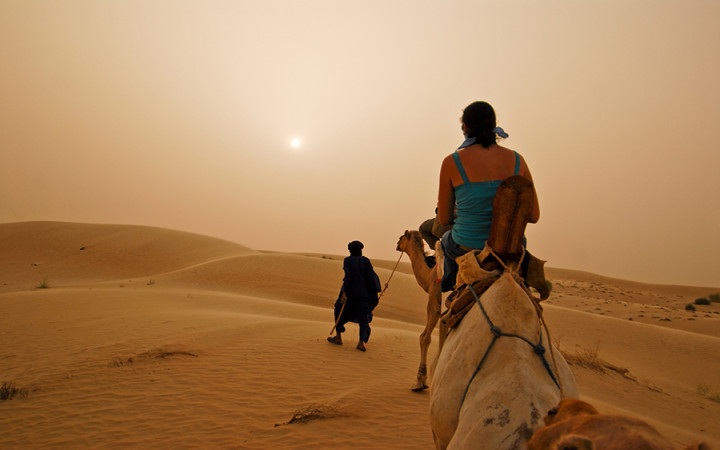Today’s Wonder of the Day was inspired by Kearsten. Kearsten Wonders, “what are sandstorms” Thanks for WONDERing with us, Kearsten!
Do you ever daydream about what it would be like to visit some of the most remote places on Earth? For example, what would it be like to sail to Antarctica and spend time just sitting on the snow and ice?
Perhaps you'd rather go to the other extreme and ride a camel across the parched Sahara Desert. As you try to endure the blistering rays of the Sun, you might find yourself wishing for a cool breeze. Be careful what you wish for, though.
While a light breeze on a hot day in the Sahara might feel refreshing, it doesn't take much for that breeze to stiffen into a wind that will pick up loose grains of sand and pelt them against everything in sight. If that happens, you've found yourself in the middle of a sandstorm!
Sandstorms occur when winds strengthen to the point where they're able to lift grains of sand off the ground and blow them through the air. They tend to happen most frequently in sandy areas, such as deserts. For example, sandstorms are quite common in the Sahara Desert.
Similar storms can arise in many areas around the world. When the top layer of soil consists primarily of dirt and rock rather than sand, these storms are usually called dust storms. Some people use the terms interchangeably, although one term or the other is usually more correct depending upon what type of particle is being blown about by the wind.
For example, many dry, flat areas of the United States, such as Kansas, Oklahoma, Texas, New Mexico, and Arizona, experience dust storms and sandstorms frequently, especially during periods of drought. Moisture tends to hold particles to the ground, so dry conditions often lead to particles being picked up more easily by the wind.
Areas of China, Mongolia, Africa, and the Middle East also often see these types of storms. Sandstorms and dust storms that result from microbursts or downbursts from thunderstorm cells are often known by a special name: haboob. This name comes from the Arabic word habb, which means "wind."
Sandstorms can arise quickly and without much warning. Wind speeds as low as 25 miles per hour can cause sandstorms, so it doesn't take hurricane-force winds to get sand particles moving through the air. The faster the wind blows, the higher and farther the particles can be blown.
Sandstorms can be very dangerous. Since they can reduce visibility to near zero, sandstorms make traveling difficult. Blowing sand and dust particles can also find their way into the tiniest cracks and crevices in machinery, causing frequent mechanical breakdowns.
Sandstorms can also pose a variety of health problems, since sand and dust flying through the air can find its way into your eyes, nose, mouth, and lungs. During a sandstorm, people should wear some type of mask that will filter out these particles.





